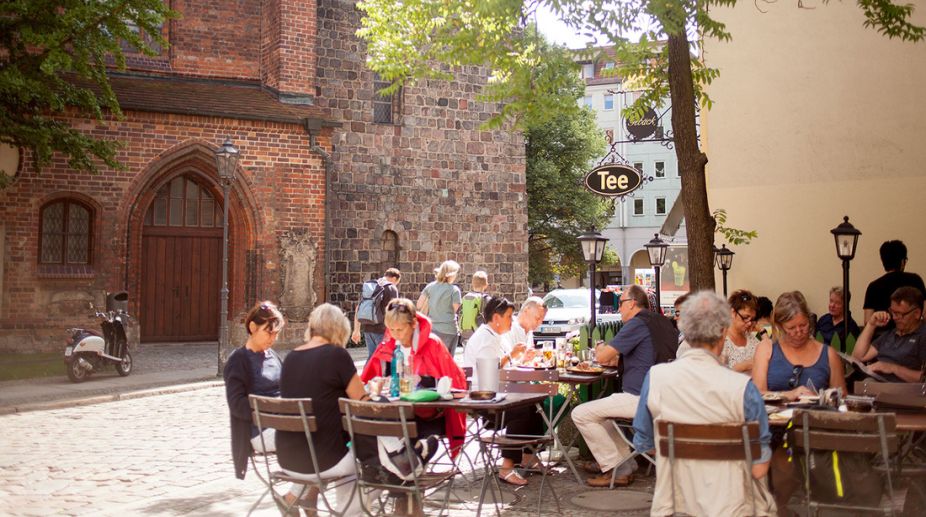With the neo-classical grandeur of the Brandenburg Gate staring me in the face, I sat down for a quick bite and a much-needed drink at a pop-up Turkish eatery. I was in Berlin on work, which fortuitously ended ahead of schedule, leaving me with some time on my hands on a balmy summer evening.
After dumping my stuff at the hotel, I resolved to explore Berlin, or to be precise, as much of Berlin as I could, on foot. Fortunately, my hotel was in the Mitte area, bang in the centre of the city, only one of the two boroughs comprising both the former East and West Germany, with government quarters, major attractions and landmarks conveniently arrayed.
Walking along the banks of the river Spree, I, like a camera with its shutter open, had ambled into the Berliner
Dom, the main protestant church in the city just as the evening worship was ending with rich sound of the venerable
organ reverberating inside the grand interiors.
Instead of saints, sculpted figures of Luther and Calvin looked down benignly on the worshippers. Outside, on the steps, a wizened old man with his cap spread out in front of him, played, what seemed to my untrained ear, a plaintive Arab melody on his rickety accordion.
Under the massed linden trees I walked, past the grand façade of Humboldt University which, among others, Marx and Bismarck attended and where Einstein taught; past the Reichstag — the German Parliament —where a controversial incident of arson set the stage for Nazi hegemony at the expense of communists; all the way along the leafy urban gardens of Tiergarten to the imposingly towering victory column, a monument to Prussian military triumph in the 19th
century.
Hubris is emblazoned in the architectural escutcheon of Berlin but the pathosladen sub-text of all that can go wrong and did, abounds too. Following an incendiary speech by Goebbels, more than 20,000 books by Marx, Freud, Thomas Mann, Stephen Zweig and other intellectuals, whose views appeared to challenge the Nazi propaganda machine, were burnt at Bebelplatz, a public square surrounded by Humboldt University, the opera house and St Hedwig’s Cathedral.
A modest yet poignant memorial with a glass plate set into the cobbles, stands today offering a glimpse of empty bookcases with enough space to hold all the books and a line from a Heinrich Heine play, “That was only a prelude; where they burn books, they will in the end also burn people”. As indeed they did! Just a block south of the Brandenburg gate is the austere memorial to the three million murdered Jews of Europe, the holocaust memorial on the site of a section of the former Berlin Wall — the “death strip”, standing as a silent warning to a modern day, complacent humanity.
After my pit stop, I started on the Berlin Wall trail. Certain that I could not cover the entire 150 kilometre stretch
in what was left of the evening, I headed directly for Checkpoint Charlie, the focal point of the Cold War and the setting
for the beginning and ending of my favourite John le Carré book, The Spy Who Came in from the Cold. Only
a replica version of the iconic guardhouse now remains, a “fake” hut installed to satisfy kitsch-loving tourists.
Barely a tear shed for Peter Fechter, shot in the pelvis by East German guards while trying to escape; whose
body lay tangled in a barbed wire fence as he lay dying in a pool of blood in no man’s land, in full view of the world’s
media. Makeshift soldiers in “fake” uniforms with “fake” accents displayed their stuff to the callous applause of an
insensate, selfie-stick wielding crowd, used to framing their life experiences in 140 characters for the gratuitous
benefit of their fellow twitterati.
Propelled by my aching limbs, I made my weary way to the solitary comforts of my hotel room. I felt a slight chill
in the air as the sun began its descent for the day. I passed by the Tränenpalast — the “Palace of Tears” — the former
border-crossing where East Germans bid tearful farewells to visitors going back to West Germany. Quite surprisingly, the words of an American President came back to me, “There are no constraints on the human mind, no walls around the human spirit, no barriers to our progress except those we ourselves erect”.
Surely he did not have Berlin in mind!
“The wall’s back in business”, said the man across the counter of a souvenir shop with a heavy Bavarian accent as he
handed me a paperbag with an alleged piece of the Berlin Wall in it. Back home, the fragment of the “wall” nestles snugly
among the cowbells from Switzerland, clogs from Amsterdam and the lace doily from Brussels.
“Is it really part of the original wall”, we are invariably asked whenever a visitor catches a glimpse of the tiny piece
of rubble winking at them from the living room display cabinet. Perhaps it is, perhaps not but who cares? It is a souvenir,
but unlike a key-ring, coaster or fridge magnet, which remind us of pleasant memories of travel, this little piece
of concrete, authentic or not, is an unhappy reminder of so many worlds broken into fragments by petty, domestic
squabbles orchestrated by selfserving ideologues.











